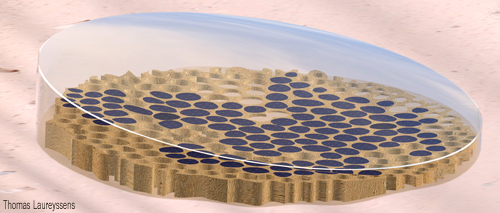Thomas Laureyssens
Designed for Site #2 in Abu Dhabi, between Saadiyat Island and Yas Island.

Design Submission for the 2010 Land Art Generator Initiative Design Competition
Artist’s descriptive text:
The Diatom Project pays homage to the species of algae that generated crude oil, the most important source of energy for our society today. The installation consists of one or more sculptures of an enlarged diatom stone fossil placed on the desert sand. Part of the diatom consists of shaped solar cells, making it an energy producing sculpture. By adding this green technology, this work marks the beginning of an era where renewable forms of energy offer alternatives that are in balance with nature.

Diatoms are a major group of unicellular algae found in marine and fresh waters as well as damp soils. This microscopic life is part of the elementary basis of the food chain. Powering themselves on photosynthesis, they are encased within an often geometrically patterned cell wall of silica (silicon oxide) called a frustule. Fossil diatoms have been discovered which date from the early Jurassic (185 million years ago), but evidence suggests an origin of approximately 250 million years ago, making diatoms one of the oldest living beings on this planet. Many scientists agree that diatoms might have been the main source of crude oil. This species thus not only supplies generously to todays food chain, our modern human society is dependent on their family heritage as well.
The enlargement of a diatom to a large shape (± 3 meters, depending on the budgetary possibilities), becomes a kind of homage or monument to show respect to this species. The basis of the installation is a large ‘fossilized’ diatom carved out a local Abu Dhabi / Dubai stone by a CNC machine. No definite design for the artwork is suggested. Instead this is a proposal for a process to create a shape based on the local environment. This form comes to shape in a process that includes a collaboration of the artist with a biolab to take and analyze samples of local diatom species (e.g. Coscinodiscus sp) and producing microscopic images as well as a microscopic 3D laser scan. A selection of the species is to be made based on aesthetic criteria, production and budgetary possibilities. On top of the stone, solar cells are installed to make this a ‘functioning’ energy producing sculpture. The photovoltaic cells are shaped into organic forms by laser technology and mimics the diatoms’ photosynthetic function.

SAFETY AND ENVIRONMENTAL IMPACT
The sculpture is covered by a high strenght polycarbonate cover and on the bottom it is held in place by a small concrete foundation. There should be no risk whatsoever for either public or environment. As much as possible, materials and services will be used that are close to the place of installation, as to limit transport costs and C02 emissions.
Related Posts
1 Comment
Add comment Cancel reply
This site uses Akismet to reduce spam. Learn how your comment data is processed.

[…] that are close to the place of installation, as to limit transport costs and C02 emissions. Source: Land Art Generator Initiative Reageer […]